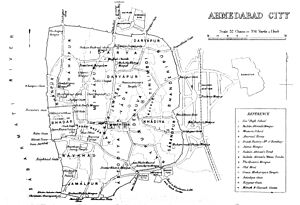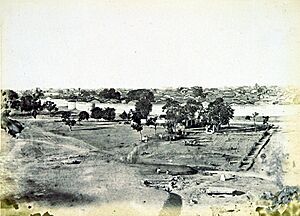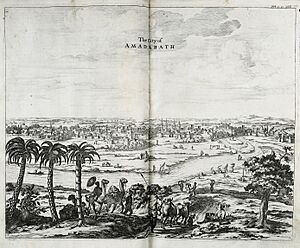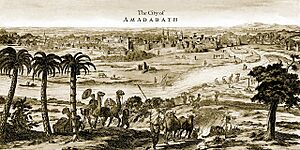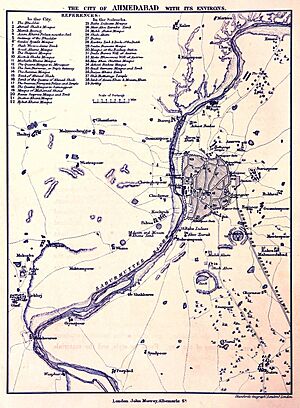History of Ahmedabad facts for kids
Ahmedabad is a big city in the state of Gujarat in western India. It sits on the banks of the River Sabarmati. For a long time, Ahmedabad has been an important center for both politics and money in the region. People first settled here around the 12th century, during the time of the Chaulukya dynasty.
The city we know today was officially started on February 26, 1411. It became the capital on March 4, 1411, thanks to Ahmed Shah I of the Gujarat Sultanate. Ahmedabad grew a lot under the Sultanate (1411–1511). It then faced some tough times (1511–1572) when the capital moved to Champaner. But for the next 135 years (1572–1707), the city became great again under the early rulers of the Mughal Empire.
Later, Ahmedabad went through a period of trouble (1707–1817) due to political changes. Things got better when the British East India Company took over in 1818. The city grew even more when it gained some freedom with its own local government and the opening of railways under British rule (1857–1947).
When Mahatma Gandhi arrived in 1915, Ahmedabad became a key place for the Indian independence movement. Many leaders, like Sardar Patel, worked in the city's local government before joining the movement. After India became independent, Ahmedabad was part of Bombay state. In 1960, when Gujarat became a separate state, Ahmedabad was its capital until Gandhinagar was built in 1965. Today, Ahmedabad is still a major cultural and economic hub in Gujarat and is the seventh-largest city in India.
Contents
Early History of Ahmedabad
Ahmedabad has a long history, with its roots going back many centuries before it was officially founded.
Chaulukya Dynasty's Influence
Around the 11th century, a ruler named Karṇa from the Chaulukya dynasty defeated a local chief named Āśā. This happened near where Ahmedabad is now. Karṇa then built temples and founded a nearby city called Karṇavatī. Sadly, these old temples are not around today.
A mosque called Kaach Masjid was built in 1053 in the Tajpur area of modern Ahmedabad. This shows that the area was already a place where different cultures met.
Delhi Sultanate Takes Over
In 1299, a battle took place near Āśāpalli. Karṇa of the Vaghela dynasty was defeated by Ullu Khāna, a general from the Delhi Sultanate. This battle ended Karṇa's rule and brought the region under the control of the Delhi Sultanate.
Gujarat Sultanate Rule (1411–1572)
The Muzaffarid dynasty played a big role in shaping Ahmedabad. Zafar Khan Muzaffar became the governor of Gujarat in 1391. He later declared himself independent in 1407, creating the Gujarat Sultanate.
The next sultan, Ahmad Shah I, was Zafar Khan's grandson. He defeated a local chief and decided to build a new city.
Founding the City
Ahmed Shah I started building the city on February 26, 1411. He chose it as his new capital just a few days later, on March 4, 1411.
There's a famous story about how Ahmedabad got its name. While camping by the Sabarmati river, Ahmed Shah I saw a hare chasing a dog. This was very unusual! His spiritual advisor explained that the land had special qualities that made even a timid hare brave. Impressed, the sultan decided to build his new capital there.
The city was named Ahmedabad in honor of four important people named Ahmad: the sultan himself, his religious teacher Shaikh Ahmad Khattu, and two others, Kazi Ahmad and Malik Ahmad.
Growth and Development (1411–1511)
Ahmed Shah I began building the Bhadra Fort in 1411, which was finished in 1413. He also created the city's first main square, Manek Chowk. Both are linked to a Hindu saint named Maneknath. The Bhadra Fort was a strong structure with eight gates.
The famous Jama Masjid, Ahmedabad was completed in 1423. As the city grew, its walls were expanded. Ahmed Shah I died in 1443.
Later, Mahmud Begada, Ahmed Shah's grandson, further strengthened the city. In 1486, he built a new outer wall that was 10 km (6.2 mi) long. This wall had 12 gates and many towers. Mahmud Begada made sure the city was beautiful, with trees lining the streets and grand buildings. He also supported traders and craftspeople. Even though the capital moved to Champaner in 1484, Ahmedabad remained a very rich and important city.
Challenges and Changes (1511–1572)
After Mahmud Begada, his son Muzaffar Shah II ruled until 1526, followed by Bahadur Shah. During this time, Gujarat faced pressure from the growing Mughal Empire and the Portuguese.
In 1535, the Mughal emperor Humayun briefly took over Gujarat and appointed his brother as governor of Ahmedabad. Bahadur Shah allied with the Portuguese and regained power, but he was later killed by them in 1537.
After Bahadur Shah's death, the power of the Gujarat Sultans weakened. The city's trade suffered because of competition from the Portuguese. The capital was moved back to Ahmedabad in 1537. The city faced more challenges, including being divided among nobles in 1554.
Despite the troubles, Ahmedabad was known for making silk, gold and silver thread, and lac. The city also had special groups called mahajans (guilds for merchants) and panches (guilds for artisans). The leader of the community, called the nagarsheth, helped solve problems and worked with royal officials. This system helped the city stay somewhat independent.
Mughal Rule (1572–1707)

The Mughal emperor Akbar conquered Gujarat in 1572, making it a province of his empire. He appointed a governor for Ahmedabad. However, rebels tried to take the city in 1573 and again in 1575. In 1583, Muzaffar Shah III, the last ruler of the Gujarat Sultanate, briefly recaptured Ahmedabad. Akbar sent his general, Mirza Khan, who defeated Muzaffar's army in 1584. Mirza Khan turned the battlefield into a beautiful garden called Fateh Bagh.
Ahmedabad continued to grow in the early 1600s. In 1613, the first representatives of the British East India Company arrived. Emperor Jahangir visited Ahmedabad in 1618 and stayed for nine months. His wife, Nur Jahan, managed the city during this time.
Prince Khurram, who later became Emperor Shah Jahan, was governor from 1616 to 1622. He built the Moti Shahi Mahal in 1621. An English traveler in 1626 described Ahmedabad as a "megapolis" (very large city) with strong walls, beautiful streets, and shops full of spices, silks, and other goods.
In 1629 and 1630, Ahmedabad suffered a terrible famine. Many people died or left the city. Soup kitchens were set up to help the poor. After the famine, the city quickly recovered.
The period from 1640 to 1670 was a golden age for Ahmedabad. Famous governors like Azam Khan and Aurangzeb ruled the city. In 1644, there was a riot between Hindus and Muslims, and a temple was damaged. In 1664, European traders were given special benefits. The city faced more challenges, including a tax on non-Muslims in 1681 and floods in 1683. Despite these issues, Ahmedabad remained a wealthy city known for its silks and gold work.
During Mughal rule, Surat became a competing trade center, but Ahmedabad remained the main city of Gujarat. It was known for its skilled craftspeople who worked with steel, gold, ivory, and textiles. The city's mint was one of only four allowed to make gold coins.
Mughal–Maratha Rule (1707–1753)
After Emperor Aurangzeb's death in 1707, a period of disorder began. The Marathas started attacking Gujarat. In 1707, they reached within five miles of Ahmedabad and were only stopped by a large payment. The city then faced riots and unrest.
For the next few decades, Ahmedabad suffered greatly due to conflicts between Mughal officers and the Marathas. The city was often attacked, taken, and retaken. Merchants and artisans left the city because of the constant fighting and high taxes.
In 1738, the city was divided between a Mughal officer, Momin Khan, and the Maratha leader Damaji Rao Gaekwad. This joint rule lasted for 15 years and was a time of almost constant trouble. The Marathas often caused problems with their demands and greed.
In 1753, the Marathas, led by the Peshwa and Gaekwad, besieged Ahmedabad. After a long siege, the Marathas finally captured the city in April 1753. This siege caused lasting damage, and many parts of the city were left empty.
Maratha Rule (1758–1817)
The Peshwa and Gaekwad shared the city's revenues, with the Peshwa managing most of the city. Ahmedabad remained under Maratha control for nearly 23 years. During the First Anglo–Maratha War (1775–1782), British forces, allied with Fateh Singh Gaekwad, stormed and captured Ahmedabad in 1779. The city was severely damaged and many people left.
After the war, Ahmedabad was returned to the Peshwa. For a few years, the city improved, and its goods were considered better than those from Surat. However, a famine in 1790 caused more distress. By the late 1790s, only a quarter of the city within the walls was still inhabited.
The city continued to face problems with governors who were oppressive and stole money. In 1817, the British East India Company gained more power. Through a treaty, the British took control of Ahmedabad from the Peshwa. The Gaekwad was allowed to keep his fort, Gaekwad Haveli, in the city. The constant power struggles between the Peshwa and the Gaekwad, along with famines, had greatly damaged Ahmedabad. Many areas were deserted, and grand houses were in ruins.
British Company Rule (1817–1857)
In 1818, the British took over the administration of Ahmedabad. In June 1819, a large earthquake hit the city, damaging many buildings. However, with political stability and lower taxes, trade began to boom, and the city became busy and rich. The population grew from 80,000 in 1817 to about 88,000 in 1824.
The city walls were repaired, and a military camp, the Ahmedabad Cantonment, was set up north of the city. Ahmedabad continued to grow, reaching a population of about 95,000 by 1846. The Hutheesing Jain Temple, completed in 1848, shows that some city merchants were very wealthy. Public funds were used to improve the city, widening streets and keeping them clean. Ahmedabad's gold, silk, and carved-wood work became famous again.
During the rebellion of 1857, the British quickly controlled any unrest in Ahmedabad. The city was disarmed, and many weapons were surrendered.
British Crown Rule (1857–1947)
From 1857 to 1865, Ahmedabad experienced great prosperity. The city's local government was established in 1858. The American Civil War (1863–1865) helped the city's economy because it increased the demand for cotton from India. The railway connecting Ahmedabad with Bombay opened in 1864, helping the city grow rapidly as a center for trade and textile manufacturing. However, the city also suffered from severe floods in 1868 and 1875, and a major fire in 1877.
The old merchant and industrial leaders in Ahmedabad were very good at business and finance. They used their own money to invest in new technologies, like British machinery. Unlike other parts of India, the entire merchant class supported these new methods. This changed traditional ways of working for hand spinners and weavers. The merchants generally supported British rule, believing it offered more security and lower taxes.
British rule did not greatly upset the community's traditional social system in Ahmedabad. The British focused on administration and military matters. Ahmedabad was different from other Indian cities because it did not have a large group of Western-educated people. Western education was introduced slower here, and there were no English-language newspapers in the 19th century.
Instead, technical education was promoted. Ranchhodlal Chhotalal, a businessman, pushed for the city to support technical training instead of just high schools. Scholarships were offered for technical students. This focus on practical skills meant that Ahmedabad did not have the same debates about tradition versus modernity that other cities had.
Schools for girls, especially for those from wealthier families, were started in the mid-19th century. Visitors noted that Ahmedabad was ahead of other places in India in promoting education for girls.
The struggle for independence soon took root in Ahmedabad. In 1915, Mahatma Gandhi returned from South Africa and set up two ashrams (spiritual communities) in the city. One was the Kochrab Ashram, and the other was the Satyagraha Ashram, later known as Sabarmati Ashram.
Gandhi started the famous Salt March in 1930 from his ashram. He and many followers walked to the coastal village of Dandi, Gujarat, to protest the British tax on salt. Before leaving, he promised not to return to the ashram until India was independent.
After Independence (1947–)
By 1960, Ahmedabad had grown into a large city with nearly half a million people. After India gained independence, Ahmedabad became a provincial town of Bombay state. On May 1, 1960, Ahmedabad became the capital of the new state of Gujarat.
During this time, many educational and research institutions were founded, making Ahmedabad a center for higher education, science, and technology. The city's economy also became more diverse with new heavy and chemical industries. Ahmedabad was seen as a successful economic model around the world.
In the late 1970s, the capital of Gujarat moved to the newly built city of Gandhinagar. This marked a period of less development for Ahmedabad. In February 1974, a student protest over hostel food prices in Ahmedabad grew into a larger movement called the Navnirman agitation. This movement led to the resignation of the chief minister of Gujarat and was one of the reasons for the Emergency declared in 1975.
In the 1980s, a policy of reserving jobs and places in education for certain groups was introduced, leading to protests and clashes in Ahmedabad in 1981 and 1985.
On January 26, 2001, a powerful earthquake struck near Bhuj, affecting Ahmedabad. Many multi-story buildings collapsed, and 752 people died. The next year, in 2002, there was a period of violence between different communities in Gujarat, which also spread to Ahmedabad. This affected the city's economy.
The Sabarmati Riverfront project, which aimed to develop the riverbanks, began in 2004. In 2008, Ahmedabad experienced a series of bomb blasts that killed and injured several people. The Ahmedabad BRTS (Bus Rapid Transit System) was opened in 2009. Construction of the Ahmedabad Metro began in 2015, and it started operating in March 2019.



